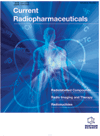- Home
- A-Z Publications
- Current Radiopharmaceuticals
- Previous Issues
- Volume 3, Issue 1, 2010
Current Radiopharmaceuticals - Volume 3, Issue 1, 2010
Volume 3, Issue 1, 2010
-
-
99mTc-labeling of Peptidomimetic Antagonist to Selectively Target αvβ3 Receptor-Positive Tumor: Comparison of PDA and EDDA as Co-Ligands
More LessObjectives: The aim of this research was to synthesize radiolabeled peptidomimetic integrin αvβ3 antagonist with 99mTc for rapid targeting of integrin αvβ3 receptors in tumor to produce a high tumor to background ratio. Methods: The amino terminus of 4-[2-(3,4,5,6-tetra-hydropyrimidin-2-ylamino)-ethyloxy]benzoyl-2-(S)-[N-(3-amino-- neopenta-1-carbamyl)]-aminoethylsulfonyl- amino-β-alanine hydrochloride (IAC) was co Read More
-
-
-
Evaluation of [11C]S14506 and [18F]S14506 in Rat and Monkey as Agonist PET Radioligands for Brain 5-HT1A Receptors
More LessAuthors: Shuiyu Lu, Jeih-San Liow, Sami S. Zoghbi, Jinsoo Hong, Robert B. Innis and Victor W. PikeIn vitro and ex vivo measurements have shown that the binding of the selective high-affinity agonist, S14506 (1-[2-(4-fluorobenzoylamino)ethyl]-4-(7-methoxy-naphthyl)piperazine), to 5-HT1A receptors, is similar in affinity (Kd = 0.79 nM) and extent (Bmax) to that of the antagonist, WAY 100635. We aimed to test whether S14506, labeled with a positron- emitter, might serve as a radioligand for imaging brain 5-HT1A rece Read More
-
-
-
Hypoxia in DU-145 Prostate Cancer Xenografts after Estramustine Phosphate and Radiotherapy
More LessPurpose: Practically all solid malignant tumours have central hypoxia, which makes them less vulnerable to most forms of both radiotherapy and chemotherapy. Estramustine phosphate (EMP) is known to sensitise cancer cells and tumours to irradiation and to increase blood flow in malignant tumours. This study was designed to assess the effect of EMP and radiotherapy on the oxygenation status of the tumours. Methods and Read More
-
-
-
Twenty-Eight Years' Survival with Metastatic Phaeochromocytoma Treated by Repeated [131I] Metaiodobenzylguanidine Therapy
More LessAuthors: M. R. S. Brothwell and H. H. LucraftPheochromocytoma is a rare neuroendocrine tumour. The prognosis after metastasis is poor, but there have been rare cases of prolonged survival of up to 26 years. Treatments for malignant phaeochromocytoma include surgical debulking, pharmacological control of hormone-mediated symptoms, 131I-metaiodobenzylguanidine (MIBG) therapy, chemotherapy and hormone therapy such as somatostatin analogues. We re Read More
-
-
-
[177Lu]-DOTA0-Tyr3-Octreotate: A Potential Targeted Radiotherapeutic for the Treatment of Medulloblastoma
More LessMedulloblastoma, the most common pediatric brain tumor, is difficult to treat because conventional therapeutic approaches result in significant toxicity to normal central nervous system tissues, compromising quality of life. Given the fact that medulloblastomas express the somatostatin subtype 2 receptor, [177Lu-DOTA0,Tyr3]octreotate ([177Lu]DOTA-TATE) could be a potentially useful targeted radiotherapeutic for the tr Read More
-
-
-
Radio-Iodination Methods for the Production of SPECT Imaging Agents
More LessAuthors: K. M. Wager and G. B. JonesMolecular imaging via Single Photon Emission Computed Tomography (SPECT) holds considerable promise for analysis of metabolism and bio-distribution of drugs in addition to imaging of diseased states. While the related Positron Emission Tomography (PET) imaging offers higher resolution images, SPECT is considered the more practical approach to nuclear imaging for routine diagnostic use. One of the attractive Read More
-
-
-
Gastric Ulcer Complicating a Selective Internal Radiation Therapy (SIRT) Procedure for Colorectal Carcinoma Metastasized to the Liver
More LessAuthors: K.A. Krajewski, M.A. Mazepa, S. Glinberg and K.D. HolenColorectal cancer presents with metastatic disease in approximately 20% of newly diagnosed patients [1]. As surgery offers hope for a cure and only 25% of cases are resectable, regional therapy is an important option for the remaining patients. Selective Internal Radiation Therapy (SIRT) is a therapy that has been shown to provide significant local control in the liver and is generally well tolerated. Despite appropriate steps t Read More
-
-
-
Review: Technegas - 99mTc-Metal Core Graphite Nanoparticles for Pulmonary Ventilation Imaging
More LessAuthors: Leonard I Wiebe, William M Burch and Douglas N AbramsTechnegas, a carbon-coated Tc-99m nanoparticulate aerosol invented by Burch at the Australian National University in 1984, was introduced to the medical community in 1986 with two reports of its use as a new ventilation agent for lung imaging. Since that time, more than 1,500 Technegas machines have been distributed in hospitals and clinics in 54 countries, and more than 2 million Technegas ventilation studies have been Read More
-
-
-
Detecting Growing Mammary Tumors with Monoclonal Antibodies Against Vascular Endothelial Growth Factor Receptor - 3
More LessAuthors: Paivi Karnani, Kalevi Kairemo and Ilari PaakkariBiodistribution of the monoclonal antibody (mAb 9d9f9) against the vascular endothelial growth factor receptor- 3 (VEGFR-3) is studied here in the rat. VEGFR-3 is expressed on endothelial cells of lymphatic endothelium during the tissue growth. The mAb9d9f9 is the first specific molecular marker to the endothelial cells of high venules. The specificity was detected with immunohistochemistry of tissue samples. Materials The Read More
-
Volumes & issues
Most Read This Month
Article
content/journals/crp
Journal
10
5
false
en


